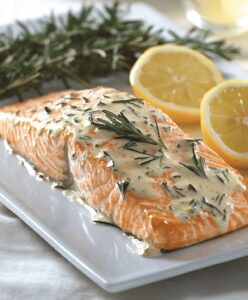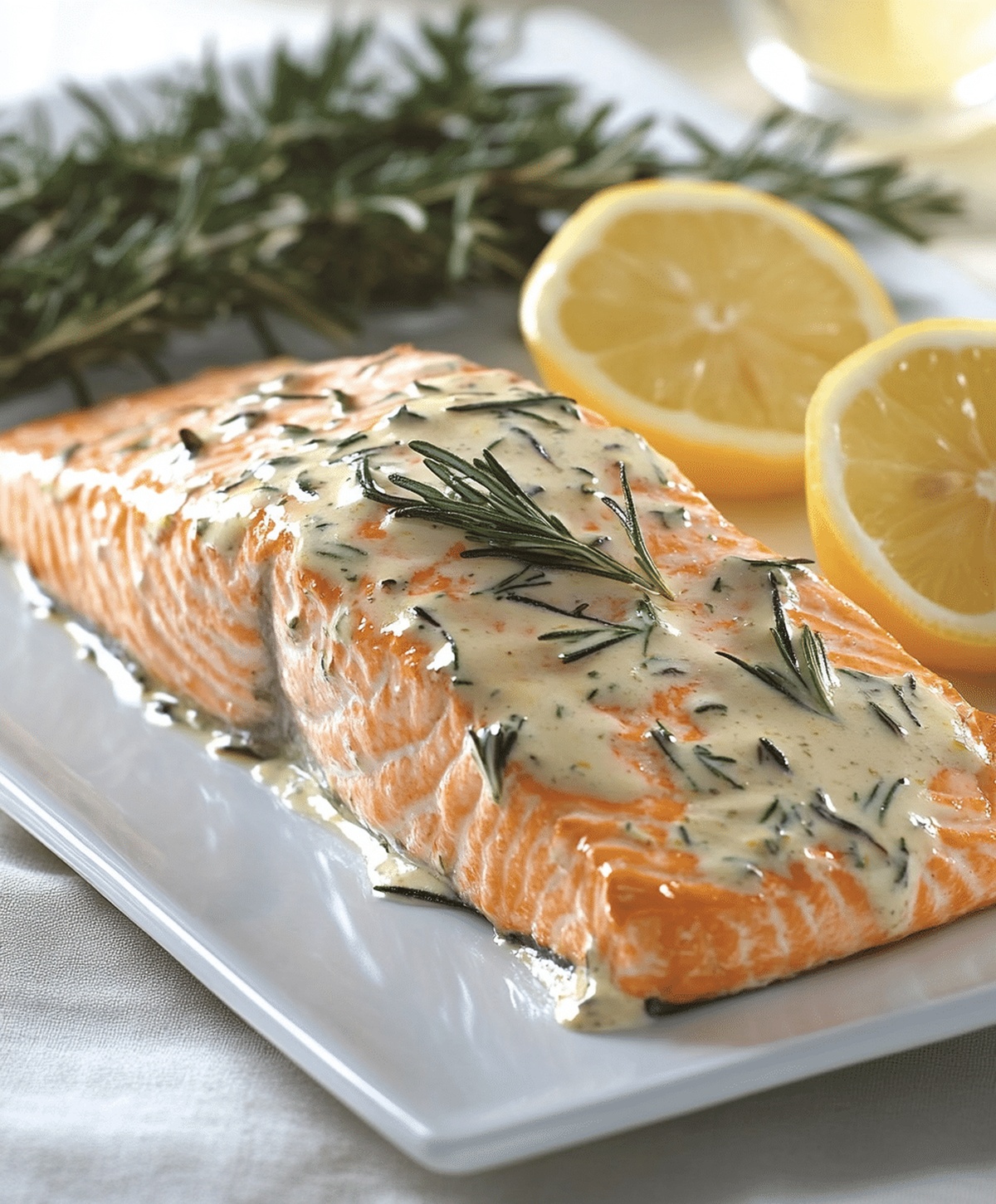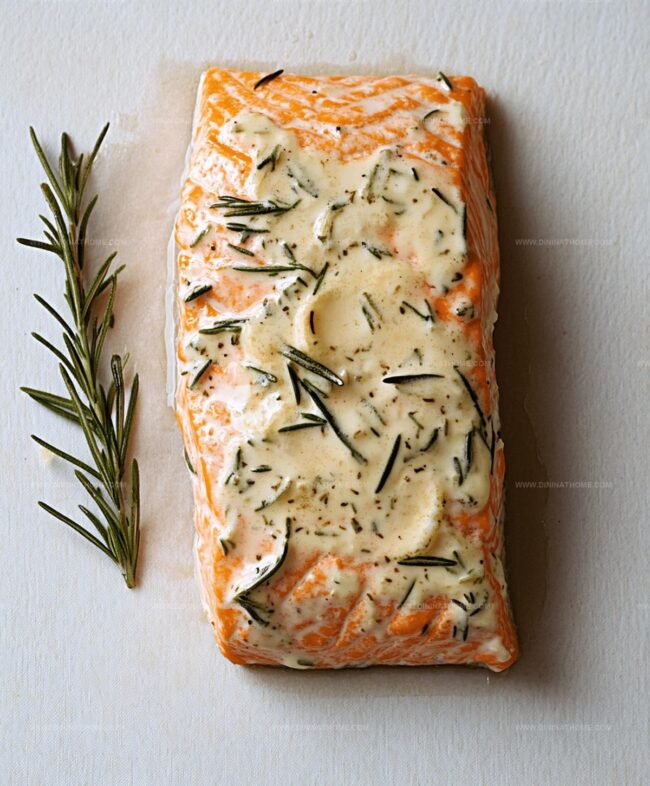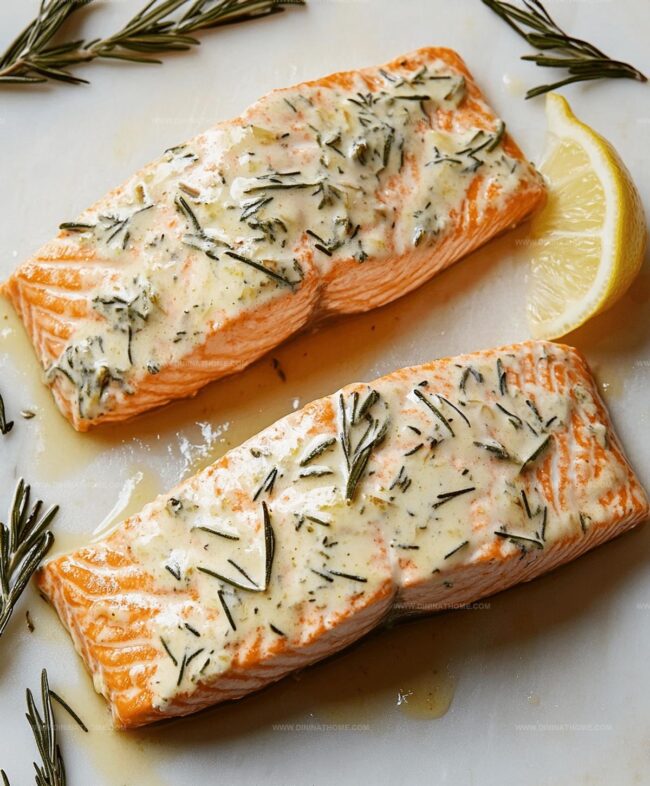The Zesty Lemon Rosemary Salmon Recipe Everyone Will Love
Fresh ocean salmon meets earthy rosemary in a culinary dance that whispers Mediterranean summers.
Fragrant herbs weave magic through delicate fish fillets, creating unexpected flavor symphonies.
Crisp citrus notes brighten each tender bite with zesty complexity.
Weeknight meals transform into gourmet experiences through simple yet sophisticated techniques.
Home kitchens become flavor laboratories where classic ingredients spark extraordinary combinations.
Quick preparation ensures maximum taste with minimal effort.
Lemon Rosemary Salmon That’s So Fresh
Lemon Rosemary Salmon Preparation Ingredients
Main Proteins:Flavor Enhancers:Seasoning:Lemon Rosemary Salmon Step Sequence
Step 1: Warm Up the Oven
Set your oven to a cozy 375°F and grab a baking sheet.
Line it with parchment paper to prevent any sticky situations and make cleanup a breeze.
Step 2: Create a Flavor Explosion
Grab a small mixing bowl and whip up a magical marinade with these tasty ingredients:Whisk everything together until the marinade looks smooth and inviting.
Step 3: Prepare the Star of the Show
Place your salmon fillets on the prepared baking sheet with the skin facing down.
Using a basting brush, generously coat the salmon with your delicious marinade.
Make sure every inch gets some love from the flavor mixture.
Step 4: Bake to Perfection
Slide the baking sheet into the preheated oven and let the salmon cook for 12-15 minutes.
You’ll know it’s ready when the fish easily flakes apart with a gentle touch of a fork.
Step 5: Serve with Style
Finish your masterpiece by garnishing with fresh lemon slices.
Serve the salmon immediately while it’s warm and bursting with herbal and citrusy notes.
Lemon Rosemary Salmon Tips for Tender Fillets
Store Lemon Salmon Carefully For Reuse
Perfect Pairings for Lemon Rosemary Salmon
Lemon Rosemary Salmon with Bright Flavor Combos
FAQs
Yes, you can substitute dried rosemary, but use about one-third the amount as dried herbs are more concentrated. Crush the dried rosemary between your fingers before adding to release more flavor.
Check the internal temperature with a meat thermometer – it should reach 145°F (63°C). Alternatively, the salmon should flake easily with a fork and appear opaque throughout.
Both work perfectly. Skin-on salmon can help keep the fish moist during cooking, but skinless salmon will also turn out delicious with this recipe. Just ensure even coating of the marinade.
Wild-caught salmon like sockeye or king salmon are excellent choices. Atlantic salmon also works well. Choose fresh, high-quality salmon for the best flavor and texture.
Print
Lemon Rosemary Salmon Recipe
- Total Time: 25 minutes
- Yield: 4 1x
Description
Succulent lemon rosemary salmon delivers Mediterranean coastal charm right onto dinner plates. Herb-infused fillets blend citrus brightness with earthy rosemary, promising a restaurant-quality experience you’ll savor with each delightful bite.
Ingredients
Protein:
- 4 salmon fillets (6 ounces / 170 grams each)
Herbs and Aromatics:
- 1 tablespoon fresh rosemary, finely chopped
- 2 garlic cloves, minced
- 2 teaspoons lemon zest
Liquid and Seasoning:
- 2 tablespoons olive oil
- 2 tablespoons fresh lemon juice
- 1/2 teaspoon salt
- 1/4 teaspoon black pepper
Garnish:
- Lemon slices
Instructions
- Prepare the oven environment by heating to 375°F and creating a non-stick surface with parchment paper on a baking sheet.
- Create a vibrant marinade by blending olive oil, freshly squeezed lemon juice, fragrant lemon zest, minced garlic, chopped rosemary, and seasoning with salt and pepper.
- Position salmon fillets with their skin facing downward on the prepared baking sheet, ensuring even placement.
- Generously coat the salmon with the prepared herbal marinade, allowing the flavors to infuse into the fish’s surface.
- Transfer the baking sheet into the preheated oven and roast for 12-15 minutes, monitoring the salmon’s texture until it becomes delicately flaky when tested with a fork.
- Remove from the oven and enhance the presentation by adorning the salmon with bright, thin lemon slices.
- Serve the salmon immediately while still warm, capturing the peak of its aromatic and tender qualities.
Notes
- Ensure salmon is at room temperature before cooking to promote even heating and prevent dry edges.
- For a gluten-free and dairy-free option, confirm all ingredients like olive oil are pure and uncontaminated.
- Swap fresh rosemary with dried herbs if fresh isn’t available, using approximately one-third the quantity to maintain balanced flavor intensity.
- Pat salmon completely dry with paper towels before seasoning to help achieve a beautifully crisp exterior and prevent steaming instead of roasting.
- Prep Time: 10 minutes
- Cook Time: 15 minutes
- Category: Dinner, Lunch
- Method: Baking
- Cuisine: Mediterranean
Nutrition
- Serving Size: 4
- Calories: 360
- Sugar: 0 g
- Sodium: 320 mg
- Fat: 22 g
- Saturated Fat: 3 g
- Unsaturated Fat: 18 g
- Trans Fat: 0 g
- Carbohydrates: 1 g
- Fiber: 0 g
- Protein: 34 g
- Cholesterol: 90 mg






James Walker
Lead Recipe Developer & Culinary Educator
Expertise
Southern Cuisine & Farm-to-Table Cooking, Recipe Development & Testing, Culinary Education & Instruction
Education
School: Auguste Escoffier School of Culinary Arts
Program: Diploma in Culinary Arts and Operations
Focus: Comprehensive training in classical and modern culinary techniques, kitchen operations, and farm-to-table practices.
James didn’t learn cooking from a TV show, he learned it from busy kitchens, family gatherings, and long afternoons spent testing recipes the hard way.
After training at the Auguste Escoffier School of Culinary Arts, he brought his love for real, down-to-earth food to every dish he makes.
At Dining At Home, James loves building recipes that feel familiar but still have something special, like adding a twist to a classic or making a slow Sunday dinner feel brand new.
When he’s not in the kitchen, you’ll probably find him swapping garden tips at the farmers’ market or teaching his daughter how to flip pancakes without a mess (almost).